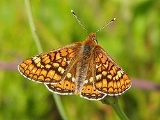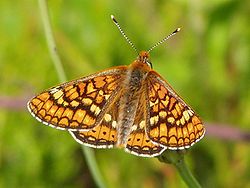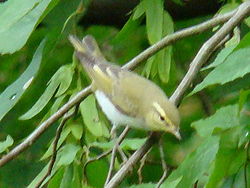
Barle Valley
Encyclopedia
Barle Valley is a 104.2 hectare
biological Site of Special Scientific Interest in Devon
and Somerset
, notified in 1997.
 The site includes the Somerset Wildlife Trust
The site includes the Somerset Wildlife Trust
's Mounsey Wood Nature Reserve and Knaplock and North Barton SSSI notified in 1954. The site is within Exmoor National Park.
The Barle Valley contains extensive tracts of ancient upland Sessile
Oak
ancient woodland
which exhibit variations in structure and species composition as a result of difference in past management, geology and topography. The diversity of the site is increased substantially by areas of valley mire, heathland and acid grassland. Eighty five woodland vascular plant species have been recorded including thirty one ancient woodland indicators from a single compartment. The meadows are one of the few sites for Great Burnet
(Sanguisorba officinalis) on Exmoor. Springs emerging from the base of sandstone slopes generate nutrient poor acid mires dominated by Sphagnum and Polytrichum moss carpets. The lichen flora is exceptional both for its luxuriance and in the number of rare species. One hundred and sixty five taxa of epiphytic lichens are present containing a remarkably
large proportion of ancient woodland indicators giving the Barle a very high index of ecological continuity.
 The site contains an outstanding assemblage of woodland breeding birds including particularly high densities of Wood Warbler
The site contains an outstanding assemblage of woodland breeding birds including particularly high densities of Wood Warbler
(Phylloscopus sibilatrix), Redstart
(Phoenicurus phoenicurus) and Pied Flycatcher (Ficedula hypoleuca). These are all Summer visitors.
The River Barle
provides an important habitat for Kingfisher
(Alcedo atthis), Dipper
(Cinclus cinclus) and Grey Wagtail
(Motacilla cinerea), while scrub and heath have breeding Stonechat
(Saxicola torquata) and Whinchat
(Saxicola rubetra).
(Eurodryas aurinia) and nationally vulnerable High Brown Fritillary
(Argynnis adippe). Both Roe Deer
(Capreolus capreolus) and Red Deer
(Cervus elaphus) graze areas of wood pasture. The presence of Otter
s (Lutra lutra) on the Barle has been regularly recorded. A colony of Dormice (Muscardinus avellanarius) inhabits at least one of the Hazel
coppices.
Hectare
The hectare is a metric unit of area defined as 10,000 square metres , and primarily used in the measurement of land. In 1795, when the metric system was introduced, the are was defined as being 100 square metres and the hectare was thus 100 ares or 1/100 km2...
biological Site of Special Scientific Interest in Devon
Devon
Devon is a large county in southwestern England. The county is sometimes referred to as Devonshire, although the term is rarely used inside the county itself as the county has never been officially "shired", it often indicates a traditional or historical context.The county shares borders with...
and Somerset
Somerset
The ceremonial and non-metropolitan county of Somerset in South West England borders Bristol and Gloucestershire to the north, Wiltshire to the east, Dorset to the south-east, and Devon to the south-west. It is partly bounded to the north and west by the Bristol Channel and the estuary of the...
, notified in 1997.

Somerset Wildlife Trust
Somerset Wildlife Trust is a wildlife trust covering the county of Somerset, England.The trust, which was established in 1964, aims to safeguard the county's wildlife and wild places for this and future generations and manages almost 80 nature reserves. Examples include Fyne Court, Westhay Moor,...
's Mounsey Wood Nature Reserve and Knaplock and North Barton SSSI notified in 1954. The site is within Exmoor National Park.
The Barle Valley contains extensive tracts of ancient upland Sessile
Sessility (botany)
In botany, sessility is a characteristic of plants whose flowers or leaves are borne directly from the stem or peduncle, and thus lack a petiole or pedicel...
Oak
Oak
An oak is a tree or shrub in the genus Quercus , of which about 600 species exist. "Oak" may also appear in the names of species in related genera, notably Lithocarpus...
ancient woodland
Ancient woodland
Ancient woodland is a term used in the United Kingdom to refer specifically to woodland that has existed continuously since 1600 or before in England and Wales . Before those dates, planting of new woodland was uncommon, so a wood present in 1600 was likely to have developed naturally...
which exhibit variations in structure and species composition as a result of difference in past management, geology and topography. The diversity of the site is increased substantially by areas of valley mire, heathland and acid grassland. Eighty five woodland vascular plant species have been recorded including thirty one ancient woodland indicators from a single compartment. The meadows are one of the few sites for Great Burnet
Sanguisorba
Sanguisorba is a genus of perennial herbs or small shrubs in the family Rosaceae, native to the temperate regions of the Northern Hemisphere. The common name is Burnet. The stems grow to 50-200 cm tall, with a cluster of basal leaves, and further leaves arranged alternately up the stem...
(Sanguisorba officinalis) on Exmoor. Springs emerging from the base of sandstone slopes generate nutrient poor acid mires dominated by Sphagnum and Polytrichum moss carpets. The lichen flora is exceptional both for its luxuriance and in the number of rare species. One hundred and sixty five taxa of epiphytic lichens are present containing a remarkably
large proportion of ancient woodland indicators giving the Barle a very high index of ecological continuity.
Bird Interest on Site

Wood Warbler
The Wood Warbler is a common and widespread leaf warbler which breeds throughout northern and temperate Europe, and just into the extreme west of Asia in the southern Ural Mountains...
(Phylloscopus sibilatrix), Redstart
Common Redstart
The Common Redstart , or often simply Redstart, is a small passerine bird in the redstart genus Phoenicurus...
(Phoenicurus phoenicurus) and Pied Flycatcher (Ficedula hypoleuca). These are all Summer visitors.
The River Barle
River Barle
The River Barle runs from the Chains on northern Exmoor, in Somerset, England to join the River Exe at Exebridge, Devon. The river and the Barle Valley are both designated as biological Site of Special Scientific Interest....
provides an important habitat for Kingfisher
European Kingfisher
The Common Kingfisher, Alcedo atthis, also known as Eurasian Kingfisher or River Kingfisher, is a small kingfisher with seven subspecies recognized within its wide distribution across Eurasia and North Africa...
(Alcedo atthis), Dipper
White-throated Dipper
The White-throated Dipper , also known as the European Dipper or just Dipper is an aquatic passerine bird found in Europe, Middle East, Central Asia and the Indian Subcontinent. The species is divided into several subspecies, based primarily on colour differences, particularly of the pectoral band...
(Cinclus cinclus) and Grey Wagtail
Grey Wagtail
The Grey Wagtail is a small member of the wagtail family, Motacillidae. The species looks similar to the Yellow Wagtail but has the yellow on its underside restricted to the throat and vent. Breeding males have a black throat...
(Motacilla cinerea), while scrub and heath have breeding Stonechat
European Stonechat
The European Stonechat is a small passerine bird that was formerly classed as a subspecies of the Common Stonechat. Long considered a member of the thrush family Turdidae, genetic evidence has placed it and its relatives in the Old World flycatcher family Muscicapidae.It is 11.5–13 cm long and...
(Saxicola torquata) and Whinchat
Whinchat
The Whinchat Saxicola rubetra is a small migratory passerine bird breeding in Europe and western Asia and wintering in Africa.Its scientific name means "small rock-dweller", in reference to its habitat...
(Saxicola rubetra).
Other Species
Twenty species of butterfly have been recorded in the valley including the nationally scarce Marsh FritillaryMarsh Fritillary
The Marsh Fritillary, Euphydryas aurinia, is a butterfly of the Nymphalidae family.It is widespread in the Palaearctic region from Ireland in the West to Yakutia in the East, and to North-west China and Mongolia in the South.E. aurinia is represented by many subspecies.The most widely accepted...
(Eurodryas aurinia) and nationally vulnerable High Brown Fritillary
High Brown Fritillary
The High Brown Fritillary is a butterfly of the Nymphalidae family, native from Europe across mainland Asia to Japan.The adults fly in July/August and lay eggs near to the larval food plants which are species of violets,...
(Argynnis adippe). Both Roe Deer
Roe Deer
The European Roe Deer , also known as the Western Roe Deer, chevreuil or just Roe Deer, is a Eurasian species of deer. It is relatively small, reddish and grey-brown, and well-adapted to cold environments. Roe Deer are widespread in Western Europe, from the Mediterranean to Scandinavia, and from...
(Capreolus capreolus) and Red Deer
Red Deer
The red deer is one of the largest deer species. Depending on taxonomy, the red deer inhabits most of Europe, the Caucasus Mountains region, Asia Minor, parts of western Asia, and central Asia. It also inhabits the Atlas Mountains region between Morocco and Tunisia in northwestern Africa, being...
(Cervus elaphus) graze areas of wood pasture. The presence of Otter
Otter
The Otters are twelve species of semi-aquatic mammals which feed on fish and shellfish, and also other invertebrates, amphibians, birds and small mammals....
s (Lutra lutra) on the Barle has been regularly recorded. A colony of Dormice (Muscardinus avellanarius) inhabits at least one of the Hazel
Hazel
The hazels are a genus of deciduous trees and large shrubs native to the temperate northern hemisphere. The genus is usually placed in the birch family Betulaceae, though some botanists split the hazels into a separate family Corylaceae.They have simple, rounded leaves with double-serrate margins...
coppices.

